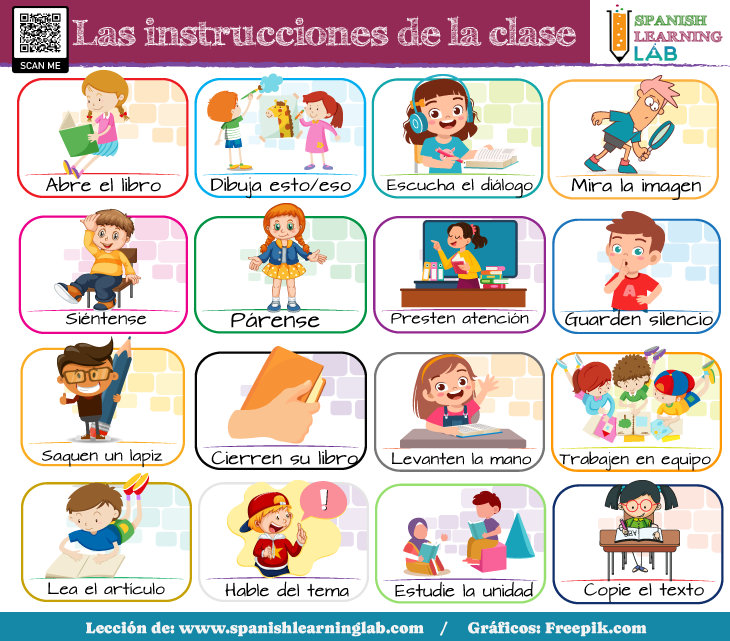Understanding commands and instructions in Spanish is really important when learning the language. In this lesson, we will learn to use verbs in the imperative tense for making classroom commands in Spanish and giving instructions in the class. You will listen to the examples of things the teacher would say in the Spanish class and practice with quizzes. Let’s begin…
Introductory video: Basic Spanish verbs for the classroom
We will begin this lesson with a short video showing 10 basic verbs that are often used in the classroom for classroom commands and instructions in Spanish – Mandatos/Instrucciones. This video includes pictures representing each verb and a few important notes on how to use them. You can activate the captions in English (cc) below. Don’t worry if you cannot understand everything, as we will explain more details later.
How to form the Imperative in Spanish – El imperativo
As shown in the video, verbs like HABLAR, ESCRIBIR, LEER and ESCUCHAR are really common when communicating with your teacher or classmates in Spanish. Particularly for the classroom, these verbs will be used in the imperative in Spanish, a tense that is used to give orders or express wishes. The imperative will only be used for pronouns in the second person such as TÚ, USTED, VOS, VOSOTROS, USTEDES.
The chart below shows how to form the imperative in Spanish of regular verbs. Notice that each verb in infinitive has a different ending (AR, ER, IR). The chart shows that “Hablar” will change to “Habla” for the pronoun “Tú”, e.g. “Tú habla primero” (You speak first!).
Conjugating verbs in the imperative in Spanish
| Pronoun | HABLAR (to talk) | ESCRIBIR (to write) | LEER (to read) |
|---|---|---|---|
| Tú | Habla | Escribe | Lee |
| Usted | Hable | Escriba | Lea |
| Vos | Hablá | Escribí | Leé |
| Vosotros | Hablad | Escribid | Leed |
| Ustedes | Hablen | Escriban | Lean |
Basic instructions and classroom commands in Spanish
Most of the time, instructions and classroom commands in Spanish will begin with a verb in imperative. This means that when giving instructions like “Open your book” , the teacher will not say “Ustedes abren sus libros” (regular conjugation of ABRIR) but “(Ustedes) abran sus libros”. It is not necessary to add USTEDES before “Abran” and actually we will omit it most of the time.
Teachers will frequently use the imperative for the pronoun USTEDES (you) to refer to the whole class. In books, you will probably see the imperative form for the pronoun USTED so instead of “(Ustedes) Completen el ejercicio”, as the teacher would indicate in class, you book’s instructions in Spanish will likely say “(Usted) Complete el ejercicio.”

In most cases, Spanish classroom commands and instructions will include these verbs: ABRIR (to open), SELECCIONAR (to choose), ESCUCHAR (to listen), MIRAR (to look), COMPLETAR (to complete), LEER (to read), CORREGIR (to correct), RELLENAR (to fill in), BUSCAR (to look up/to find), HABLAR (to talk), LEER (to read), PLANEAR (to plan), DISCUTIR (to discuss), ESCRIBIR (to write), RESPONDER (to answer) and PRACTICAR (to practice). All these verbs will change their ending according to the chart presented above, except for CORREGIR that will change to “CORRIJA(N)” and PRACTICAR to “PRACTIQUE(N)”.
A list of basic Spanish classroom commands and instructions
|
Abran sus libros en la página 30
Open your books on page 30
|
|
Seleccionen la respuesta correcta para las siguientes preguntas
Choose the right answer for the following questions
|
|
Escuche una conversación entre dos personas y luego responda las preguntas sobre ella.
Listen to a conversation between two friends and then answer the questions about it.
|
|
Mire las imágenes de la página 35 y escriba un párrafo comparándolas
Look at the pictures on page 35 and write a paragraph comparing them
|
|
Complete las siguientes preguntas con la forma correcta de los verbos.
Complete the following sentences with the right form of the verbs
|
|
Lean el primer párrafo de la lectura y luego discútanlo con su compañero.
Read the first paragraph of the reading and then discuss it with a partner
|
|
Corrija los errores de estas oraciones en español.
Correct the mistakes in these Spanish sentences
|
|
Rellene los espacios en blanco con el sustantivo correcto.
Fill in the blanks with the right noun
|
|
Busquen un compañero y planeen una conversación simple sobre el tema.
Find a partner and plan a simple conversation about the topic.
|
|
Hable sobre sus vacaciones de verano.
Talk about your summer vacations
|
|
Lean la historia y escriban un resumen de tres párrafos
Read the story and write a 3 paragraph summary
|
|
Tarea: Practique la pronunciación de la letra “r”
Homework: Practice the pronunciation of the letter “r”
|
Extra notes on instructions and classroom commands in Spanish:
As we explained in the lesson, the imperative is the basis for instructions and Spanish classroom commands. The imperative for regular verbs is not that difficult to remember with some practice because the pattern is somewhat predictable. However, not all the verbs in the language follow rules. That being said, you will find Spanish irregular verbs in the imperative mood, such as “Vaya” (You go…), “Ven…” (You come…) and “Sea” (Be…). This topic is really interesting, so we will continue learning about it in future lessons.
Before you leave, please test yourself and practice the imperative in Spanish classroom commands and instructions with this short quiz. ¡Hasta pronto!
Related Spanish Worksheets:
- The Classroom in Spanish
- The Imperative of Regular Verbs in Spanish
- Irregular Imperatives in Spanish
